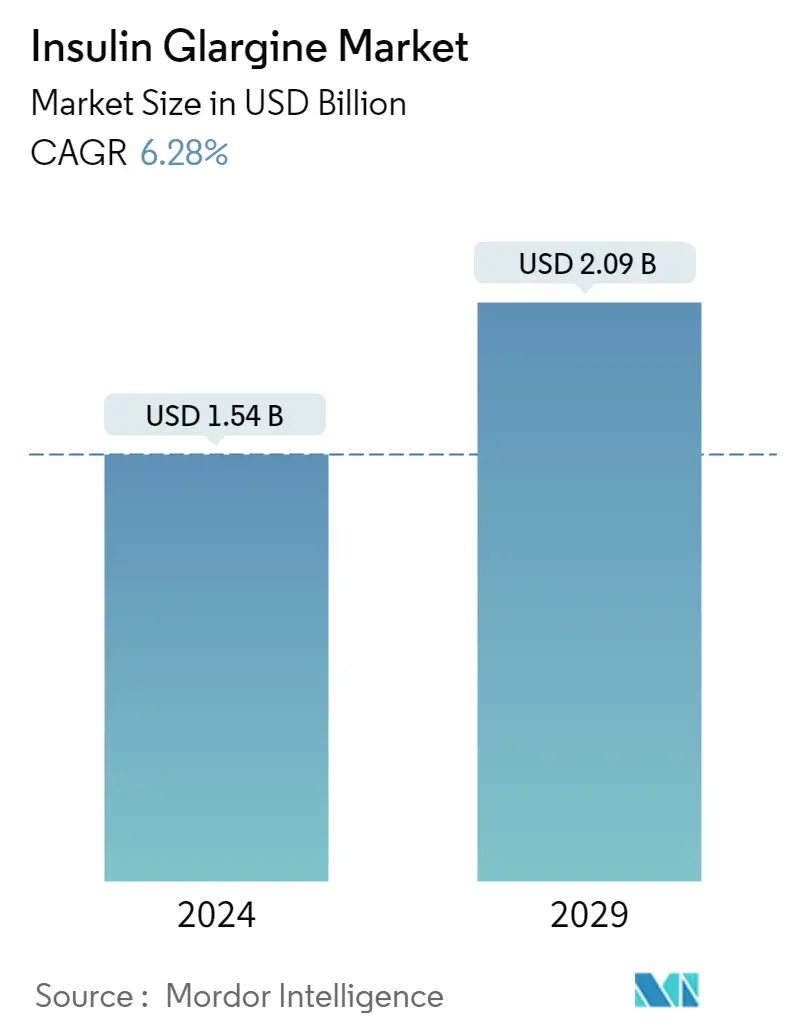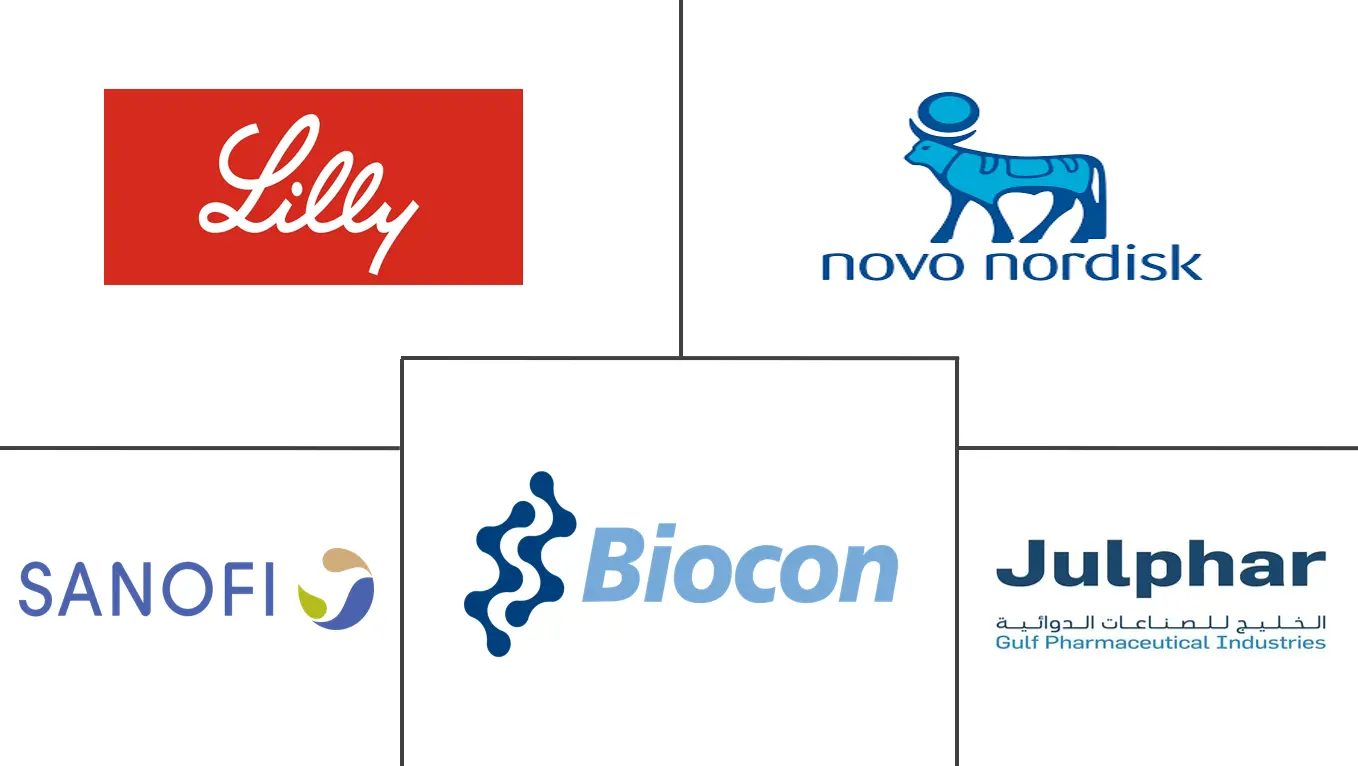Market Size of Insulin Glargine Industry

| Study Period | 2018 - 2029 |
| Market Size (2024) | USD 1.54 Billion |
| Market Size (2029) | USD 2.09 Billion |
| CAGR (2024 - 2029) | 6.28 % |
| Fastest Growing Market | North America |
| Largest Market | North America |
Major Players
*Disclaimer: Major Players sorted in no particular order |
Insulin Glargine Market Analysis
The Insulin Glargine Market size is estimated at USD 1.54 billion in 2024, and is expected to reach USD 2.09 billion by 2029, growing at a CAGR of 6.28% during the forecast period (2024-2029).
The COVID-19 pandemic has resulted in a surge in diabetic complexities, which is driving the insulin demand in the market. Type 1 diabetes can be characterized as insulin-requiring, while Type 2 diabetes can be characterized as insulin-dependent diabetes. People with diabetes have a 300% increased risk of being hospitalized compared to those without diabetes, and, thus, they incur more healthcare expenses than non-diabetic people. Patients with Type 2 diabetes require many corrections throughout the day to maintain nominal blood glucose levels, such as the administration of additional insulin or ingestion of additional carbohydrates. Achieving nominal results can be very difficult without multiple daily injections of insulin or insulin pump therapy. This is driving the demand for insulin on a global scale, which is expected to drive the market studied during the forecast period.
Insulin Glargine Industry Segmentation
Insulin glargine is a long-acting type of insulin used to treat type 1 and type 2 diabetes mellitus in both adults and children. It provides a steady level of insulin in the body for 24 hours and helps control blood sugar levels. The global insulin glargine market is segmented by type (Lantus, Basaglar, Toujeo, Soliqua/Suliqua, Insulin Glargine Biosimilars) and geography (North America, Europe, Asia-Pacific, Latin America, the Middle East, and Africa). The report offers the value (in USD million) and volume (in million mL) for the above segments. This report will provide a segment-wise breakdown (value and volume) for all the countries covered under the table of contents.
| Insulin Glargine | |
| Lantus | |
| Basaglar | |
| Toujeo | |
| Soliqua/Suliqua | |
| Insulin Glargine Biosimilars |
| Geography | |||||||||||||
| |||||||||||||
| |||||||||||||
| |||||||||||||
| |||||||||||||
|
Insulin Glargine Market Size Summary
The insulin glargine market is poised for significant growth over the forecast period, driven by increasing demand for insulin due to the rising prevalence of diabetes, particularly in the wake of the COVID-19 pandemic. The market is characterized by the need for insulin in managing both Type 1 and Type 2 diabetes, with patients requiring multiple daily injections or insulin pump therapy to maintain blood glucose levels. The introduction of new products like Sanofi's Toujeo and the expansion of its indications have contributed to market dynamics, while biosimilars like Basaglar are gaining traction due to their cost-effectiveness. The United States remains a critical market, with Humalog leading in sales, supported by substantial government and private insurance coverage for diabetes care.
The global insulin glargine market is moderately consolidated, with major players such as Sanofi, Novo Nordisk, and Eli Lilly dominating the landscape. These companies have established strong market positions through strategic alliances and acquisitions, enhancing their global presence and market penetration. The North American market, particularly the United States, holds a significant share due to the high incidence of diabetes and the affordability of traditional human insulin. Despite the presence of new-generation insulin glargine products, traditional brands like Novolin and Humulin continue to perform well. The market's growth is further supported by collaborations and regulatory approvals, ensuring a competitive environment with limited generic competition in the North American region.
Insulin Glargine Market Size - Table of Contents
-
1. MARKET DYNAMICS
-
1.1 Market Overview
-
1.2 Market Drivers
-
1.3 Market Restraints
-
1.4 Porter's Five Forces Analysis
-
1.4.1 Bargaining Power of Suppliers
-
1.4.2 Bargaining Power of Buyers/Consumers
-
1.4.3 Threat of New Entrants
-
1.4.4 Threat of Substitute Products
-
1.4.5 Intensity of Competitive Rivalry
-
-
-
2. MARKET SEGMENTATION
-
2.1 Insulin Glargine
-
2.1.1 Lantus
-
2.1.2 Basaglar
-
2.1.3 Toujeo
-
2.1.4 Soliqua/Suliqua
-
2.1.5 Insulin Glargine Biosimilars
-
-
2.2 Geography
-
2.2.1 North America
-
2.2.1.1 United States
-
2.2.1.2 Canada
-
2.2.1.3 Rest of North America
-
-
2.2.2 Europe
-
2.2.2.1 France
-
2.2.2.2 Germany
-
2.2.2.3 Italy
-
2.2.2.4 Spain
-
2.2.2.5 United Kingdom
-
2.2.2.6 Russia
-
2.2.2.7 Rest of Europe
-
-
2.2.3 Latin America
-
2.2.3.1 Mexico
-
2.2.3.2 Brazil
-
2.2.3.3 Rest of Latin America
-
-
2.2.4 Asia-Pacific
-
2.2.4.1 Japan
-
2.2.4.2 South Korea
-
2.2.4.3 China
-
2.2.4.4 India
-
2.2.4.5 Australia
-
2.2.4.6 Vietnam
-
2.2.4.7 Malaysia
-
2.2.4.8 Indonesia
-
2.2.4.9 Philippines
-
2.2.4.10 Thailand
-
2.2.4.11 Rest of Asia-Pacific
-
-
2.2.5 Middle East and Africa
-
2.2.5.1 Saudi Arabia
-
2.2.5.2 Iran
-
2.2.5.3 Egypt
-
2.2.5.4 Oman
-
2.2.5.5 South Africa
-
2.2.5.6 Rest of Middle East and Africa
-
-
-
Insulin Glargine Market Size FAQs
How big is the Insulin Glargine Market?
The Insulin Glargine Market size is expected to reach USD 1.54 billion in 2024 and grow at a CAGR of 6.28% to reach USD 2.09 billion by 2029.
What is the current Insulin Glargine Market size?
In 2024, the Insulin Glargine Market size is expected to reach USD 1.54 billion.

